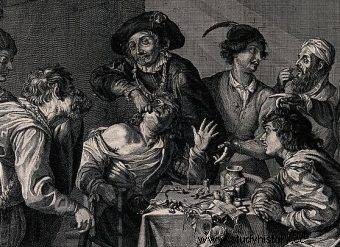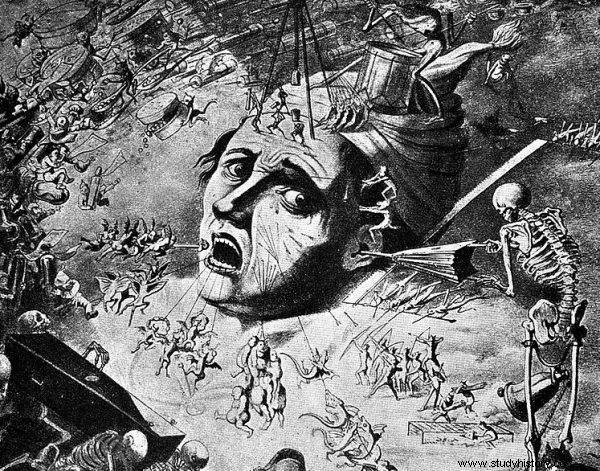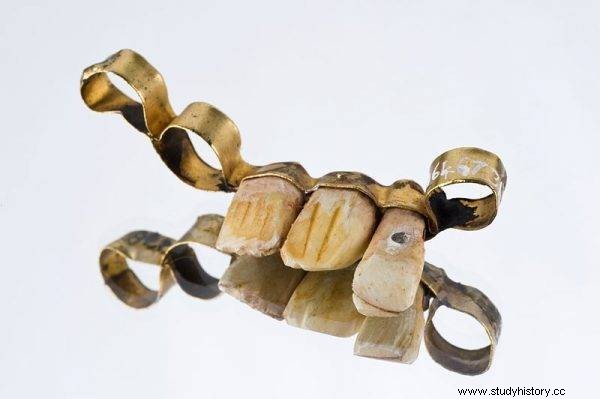People have always hurt teeth and people have always tried to fight this pain. The only question is whether the method used will work, or will it only increase the suffering, and even ... kill the patient?
Shakespeare very aptly wrote:"There has not yet been a philosopher who could calmly endure toothache." Since the dawn of time, attempts have been made to fight the ailments of the "red stable full of white horses". The technique of tearing out - or rather knocking out - broken pieces with a stone quickly turned out to be not very effective and definitely too painful (and after all, dental surgery developed relatively recently). So people resorted to magic, prayer, superstition and - as it usually happens, last of all - to science.

Since the dawn of time, attempts have been made to fight the ailments of the "red stable full of white horses".
The first surviving attempts to write down and systematize knowledge in the field of dentistry date back to about 5000 years BC and are the work of Babylonian scientists. It was believed then that the demons or worms living in the teeth were responsible for the disease. And that you can get rid of both by using the appropriate methods…
Leviticus Statistics
The directions for treating the teeth were immortalized on clay tablets with cuneiform writing. It is from them that we can find out what methods the Babylonians used and where, in their opinion, tooth worms came from. James Wynbrandt in his book The Painful History of Dentistry refers:
" Legend of the Worm" provides tips to follow when you want to get rid of Marduknadinach - simply a toothache in today's nomenclature dental. In order to destroy it, one must turn to Ea, god of the abyss, and Anu, god of heaven by reciting the incantation that tells about the birth of a toothworm.
The trick was to grind henbane and mastic (herbaceous plant and resin obtained from the juices of a certain species of pistachios), put the paste on the top of the tooth and utter the appropriate spell.

In ancient Babylon, the demons or worms in the teeth were believed to be responsible for the disease.
Of course, there were many similar methods. Those patients who felt relieved after treatment wrote down a medical history on a tablet and hung it in the temple. Then the priests looked at the accounts left behind and selected the ones that contained the most valuable information. This is how the first textbooks of medicine in history - including dentistry - were written!
Interestingly, the teeth were treated not only in the event of pain. Their condition was also treated as an indicator of the patient's health. The predictions made from dentition were not always accurate - for example, a collection of tablets entitled "When a Sorcerer Visits a Patient's Home" contained a diagnosis that people with narrow teeth would die imminently, and those whose teeth had fallen out would collapse ...
Vacuum the worm
The "temple" methods - practiced by shamans or sorcerers - competed with the ever-evolving caste of professional physicians. They tried to heal based on facts, using knowledge about herbs and substances found in nature.
So the suffering Babylonians had a choice:they could offer sacrifices to a human skull placed on an apple-colored cloth for three days, pray and wear appropriate amulets ... or try the early dentists' suggestion - fumigation. This is how the procedure was described by the author of The painful history of dentistry :
First they kneaded the seeds of the black hen with beeswax, then put the mixture on the end of the glowing rod and set it on fire, then incense the tooth, directing the smoke straight into the hole . The treatment was crowned with filling the cavity with putty made of powdered henbane seeds and mastic.
The appearance of the Hammurabi code in the eighteenth century BC is a signal for historians that Babylon began to lean towards the systematization of medical knowledge, while at the same time moving away from superstition. The provisions on penalties for incompetent doctors it contains clearly prove it, although by today's standards they may seem a bit exaggerated:the doctor who led to the death of the patient was supposed to have his hands cut off.
Perhaps that is why Babylonian dentists were afraid to remove teeth, which in ancient times was associated with a very high risk of complications and death. There is also no evidence of using dentures, drilling or sealing teeth.
Tooth cult
Inferring from the earliest historical sources, the Persians and Assyrians dealt with dental disease as did the Babylonians. In contrast, the Hebrews pulled their teeth out, but treated the procedure as a last resort, preferring, for example, the treatment of pain by sucking a grain of salt.
Regardless of the culture, the teeth were provided with some form of legal guardianship. No wonder, after all, their loss was permanent, with no chance of a prosthesis! Hammurabi's code clearly defined punishments for a tooth extraction and the phrase "eye for eye, tooth for tooth" was taken very literally. Also in the Book of Exodus we read that if someone "knocked out a tooth of his slave or a slave, he should make them free for a tooth," which clearly shows how important healthy dentition was for ancient people.
The ruling caste in ancient Egypt also took great care of the teeth. In The Painful History of Dentistry we read:
A thorough examination of the mummy showed that caries and abscesses began to appear regularly among the aristocracy around 2500 BC. The birth of the privileged class of Egypt coincides with the deterioration of the dentition of high society .
That is why Egyptian aristocrats had their servants clean their mouths every day as part of their morning rituals. Moreover, dentists were highly respected in Egypt and performed important functions (for example, Hesy-Ra was simultaneously the guardian of the crown and the overseer of royal records, and Khuwy was an expert on the world of internal organs and ... anus guardian).
What doesn't kill you…
Far East doctors also believed that a mythical worm was responsible for holes in the teeth, and that the pain could be caused by an imbalance of moods ... But that's not all. According to some scholars, the aching tooth could also be the result of an abundant sex life!
The therapies recommended by dentists were often a strange combination of sensible use of natural resources and nonsensical rituals. Example?
Bake the garlic and crush it with your teeth, then add chopped horseradish seeds or saltpetre to it and mix with human milk; form a pill from the paste and put it into your nose, through the hole on the opposite side to the pain focus.
Chinese doctors also sometimes recommended a pill with arsenic, which was administered near the sick tooth - as a result, the nerve could be killed, which resulted in the relief of pain. But it might as well have ended in the patient's death.

The Etruscans already made primitive dentures
Marco Polo noticed that the inhabitants of distant Asia sometimes wear gold plates that match their teeth, which was evidence of a somewhat advanced cosmetic dentistry. Evidence for the use of primitive dental prosthetics - in the form of bridges made of gold and fragments of real teeth - dates back to 1000–400 BC. These rather complicated fillings, which were a milestone in the field of dentistry, were developed by the Etruscans living in Italy.
This, of course, is just the beginning of the history of dental treatment - a story filled with pain, dentists 'bizarre ideas and patients' horror. One thing is certain:modern dental offices are the essence of comfort and safety. You can read more about the development of this terrifying field of medicine in The Painful History of Dentistry by James Wynbrandt. The book has just been published by Marginesy.
Bibliography:
- Wynbrandt, J., A painful history of dentistry, or the crying and grinding of teeth from antiquity to modern times . Marginesy, Warsaw, 2020.
- H. H. Horch et al., Dental surgery . Urban &Partner Publishing House, Wrocław, 1997.
- History of Dentistry:Ancient Origins . American Dental Association, 2007.
